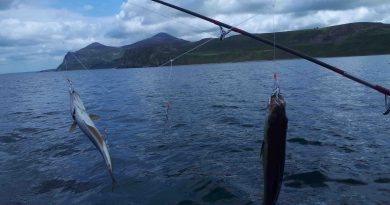Turbot
The Turbot, scientifically known as Scophthalmus maximus, is a prized flatfish inhabiting the coastal waters around the United Kingdom. Known for its distinctive diamond-shaped body and delectable white meat, the Turbot is a highly sought-after species among both recreational anglers and commercial fisheries. In this article, we will delve into the various facets of the Turbot, examining its sizes, habitat, prey, and gender differences to gain a comprehensive understanding of this fascinating fish in the UK waters.
Sizes: Turbot are renowned for their impressive sizes, with adults often reaching lengths of 24 to 35 inches (60 to 90 cm) and occasionally exceeding 3 feet (90 cm). In terms of weight, these flatfish can weigh anywhere from 5 to 15 pounds (2.3 to 6.8 kg), making them a substantial catch for anglers and a valuable target for commercial fishing operations.
Habitat: Turbot are typically found in sandy or muddy seabeds, and they prefer depths ranging from 30 to 100 meters. They are commonly distributed in areas with a combination of sand, gravel, and shell substrates. While Turbot are known for their preference for deeper waters, they may venture into shallower areas during specific seasons, especially for feeding and reproduction. Coastal regions, estuaries, and offshore banks are among the habitats where Turbot are commonly encountered.
Prey: Turbot are voracious predators that primarily feed on fish and crustaceans. Their diet includes small fish such as sandeels, gobies, and flatfish, as well as crustaceans like crabs and shrimps. Turbot are ambush predators, lying in wait for prey to come within striking distance before swiftly engulfing them with their large mouths. This feeding strategy contributes to their success as apex predators in their habitats.
Gender Differences: Distinguishing between male and female Turbot can be challenging due to their similar external appearances. However, during the spawning season, which typically occurs in late winter and early spring, some differences become more noticeable. Female Turbot tend to be larger and rounder in the abdominal region, reflecting the presence of eggs. Males may exhibit slightly more streamlined bodies. The spawning process is vital for the continuation of the Turbot population, as it ensures the release of fertilized eggs into the water.
Conclusion: The Turbot, with its impressive sizes, specific habitat preferences, diverse diet, and subtle gender differences, stands as a remarkable species in the coastal waters of the United Kingdom. Whether pursued by anglers seeking a challenging catch or targeted by commercial fisheries for its culinary excellence, the Turbot remains an iconic and ecologically significant inhabitant of the UK’s marine environments. Understanding the nuances of the Turbot’s biology and behavior contributes to the broader appreciation of the intricate web of life in our coastal waters.


